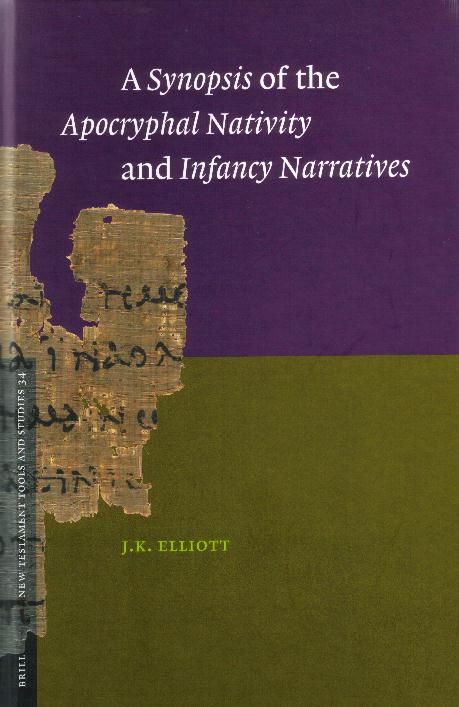Review: Infancy Gospel Synopsis

As visitors to my main web site know, my principle area of study is the Infancy Gospel of Thomas (IGT). So it was with some excitement that I heard of J.K. Elliott’s A Synopsis of Apocryphal Nativity and Infancy Narratives (New Testament Tools and Studies 34; Leiden/Boston: Brill, 2006). Even today, relatively little attention has been paid to IGT, so any new work on the text is appreciated. And the synopsis promised to be a helpful tool. I ordered the book immediately (despite the high price: $159 US) and eagerly awaited its delivery.
Unfortunately, the book does not meet my expectations. In brief: the selection of texts is limited, the synopsis is awkward, and the scholarship is not always up-to-date. This is not the kind of quality I expected from Elliott, who is well-known for his books The Apocryphal New Testament and Art and the Christian Apocrypha (with David Cartlidge), and frequently contributes to the SBL Apocrypha section.
The texts featured in the synopsis include the “usual suspects” – Protoevangelium of James, Infancy Gospel of Thomas, Pseudo-Matthew, M.R. James’ Latin Infancy Gospel (Arundel 404), Birth of Mary, and Arabic Infancy Gospel. Included also are History of Joseph the Carpenter, the fragmentary Pap. Cairensis 10735, and the Irish texts Leabhar Breac and Liber Flavus Fergusiorum. Elliott lists several other texts that could have been included—(e.g., Armenian Infancy Gospel and the Syriac Life of Mary) – but does not explain why he neglects them (p. xix). He primarily draws upon published English translations, many of them rather old—e.g., he uses older translations of the Irish material and the Arundel gospel despite the recent publication of new translations in McNamara’s volume for CCSA. To be fair, this decision may be based more on publisher’s proprietary interests than scholarly usefulness.
The synopsis is presented vertically, with each parallel printed after the next, rather than horizontally. The reason given is because “in many cases there are too many texts to have made parallel vertical columns practicable” (p. x). Nevertheless, the vertical layout reduces the synopsis’ utility. At times the Arundel and Irish texts are represented only by citations, presumably because the material is little different from the excerpts printed from the earlier texts. The stories appear in chronological order (running form the conception of Mary to Jesus at the age of 12) and include the tales from the canonical infancy narratives. On one occasion Elliott breaks from pattern to include a parallel from the Koran (Jesus animates the birds from Surah 3:49). While it is valuable for readers to observe this parallel, it makes one wonder why other parallels are not included—for example, the allusion to the same story in the Gospel of Bartholomew 2:11. Another peculiarity in the synopsis is the decision to print the three teacher stories from IGT 6, 14 and 15 one after the other, suggesting that Elliott believes them to be variants of the same story rather than tales with their own particular themes and concerns.
The synopsis is preceded with a brief discussion of the texts and select bibliographies. The IGT bibliography has some striking omissions: it neglects work on some important Syriac witnesses (Vat. syr. 159 discussed by P. Peeters in 1914, and Göttingen Syr. 10 published by W. Baars and J. Heldermann in 1993/1994), T. Rosén’s 1997 critical edition of the Slavonic text, and my own 2001 Ph. D. dissertation on the Greek tradition (and Elliott is certainly aware of it). For his text of IGT Elliott relies on the translations he made of Tischendorf’s old and inadequate texts (Greek A, Greek B, and the prologue to the Latin version). The least Elliott could have done was to translate A. Delatte’s Greek D text, the source of Tischendorf’s Latin version. In addition, Elliott makes some erroneous remarks about the IGT material: referring to Ps. Matt. 26-42, a section added to late manuscripts of Ps. Matt. from an early Latin translation of IGT, he says “These chapters are what Tischendorf called the Pars Altera. They are found in later forms of the Infancy Gospel of Thomas” (p. 132 n. 1); and he states that the story of Jesus sowing a field (IGT 12) is not found in all manuscripts of the text when, in fact, it is. The synopsis fails to include also the story of Jesus Rides a Sunbeam which is found in several infancy gospel witnesses, including the Ethiopic version of IGT and some manuscripts of Ps. Matt.
Other texts in the Synopsis also rely on out-dated text-critical work: the translations of History of Joseph the Carpenter and Arabic Infancy Gospel are from 1870 and work on these texts by contributors to the Pléiade volumes appears neglected.
To its credit, Elliott’s synopsis presents the infancy stories in a nice, tidy volume and should bring attention to the little-known Irish traditions. It is unfortunate, however, that the book is not the tool that it could be and it will be some time before another attempt is made at such a project.

http://www.xytfy.com